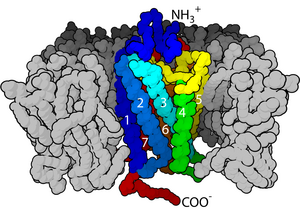
Back مستقبل سطح الخلية Arabic Površinski ćelijski receptor BS Receptor de membrana Catalan Transmembránový receptor Czech Rezeptor#Membranrezeptoren German گیرندههای سطح سلول Persian Récepteur transmembranaire French Gabhdán (fiseolaíocht) Irish Receptor de membrana Galician Reseptor permukaan sel ID

Cell surface receptors (membrane receptors, transmembrane receptors) are receptors that are embedded in the plasma membrane of cells.[1] They act in cell signaling by receiving (binding to) extracellular molecules. They are specialized integral membrane proteins that allow communication between the cell and the extracellular space. The extracellular molecules may be hormones, neurotransmitters, cytokines, growth factors, cell adhesion molecules, or nutrients; they react with the receptor to induce changes in the metabolism and activity of a cell. In the process of signal transduction, ligand binding affects a cascading chemical change through the cell membrane.
- ^ "9.3: Signaling Molecules and Cellular Receptors - Types of Receptors". Biology LibreTexts. 12 July 2018. Retrieved 24 July 2023.